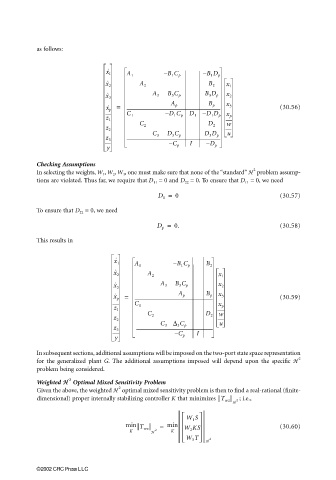Page 900 - The Mechatronics Handbook
P. 900
0066_Frame_C30 Page 11 Thursday, January 10, 2002 4:43 PM
as follows:
˙
x 1 – –
A 1 B 1 C p B 1 D p
˙
x 2 A 2 B 2 x 1
˙ A 3 B 3 C p B 3 D p x 2
x 3
˙ = A p B p x 3 (30.56)
x p
– D 1 C p D 1 –
C 1 D 1 D p x p
z 1
w
C 2 D 2
z 2
u
C 3 D 3 C p D 3 D p
z 3
– C p I – D p
y
Checking Assumptions
2
In selecting the weights, W 1 , W 2 , W 3 , one must make sure that none of the “standard” H problem assump-
tions are violated. Thus far, we require that D 11 = 0 and D 22 = 0. To ensure that D 11 = 0, we need
D 1 = 0 (30.57)
To ensure that D 22 = 0, we need
D p = 0. (30.58)
This results in
˙
x 1 –
A 1 B 1 C p B 2
˙
x 2 A 2 x 1
˙ A 3 B 3 C p x 2
x 3
x p = A p B p x 3 (30.59)
˙
C 1 x p
z 1
D 2 w
C 2
z 2
u
C 3 ∆ 3 C p
z 3
– C p I
y
In subsequent sections, additional assumptions will be imposed on the two-port state space representation
2
for the generalized plant G. The additional assumptions imposed will depend upon the specific H
problem being considered.
Weighted HH 2 Optimal Mixed Sensitivity Problem
2
Given the above, the weighted H optimal mixed sensitivity problem is then to find a real-rational (finite-
; i.e.,
dimensional) proper internally stabilizing controller K that minimizes T wz 2
H
W 1 S
min = min
T wz W 2 KS (30.60)
K H 2 K
W 3 T 2
H
©2002 CRC Press LLC

